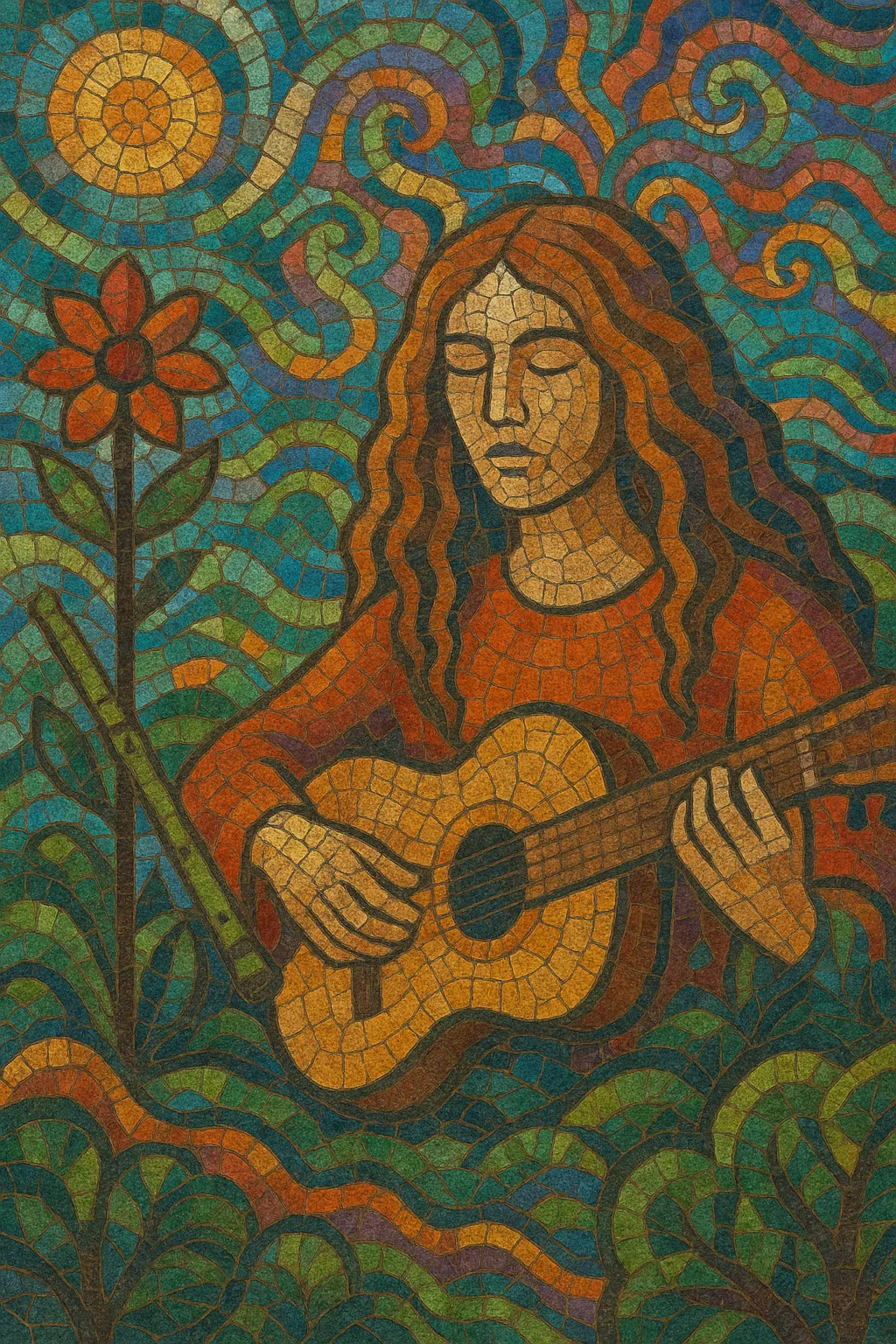
Psychedelic folk (often called acid folk or psych folk) blends the acoustic intimacy and modal harmony of traditional folk with the exploratory textures, surreal lyricism, and studio experimentation of psychedelic music.
It typically favors acoustic guitars, hand percussion, flutes, drones (e.g., tambura or harmonium), and small acoustic instruments, while embracing effects such as reverb, delay, tape manipulation, field recordings, and unconventional song structures. Lyrics tend toward the pastoral, mystical, and dreamlike—drawing on folklore, nature, and visionary or inward-looking themes.
Musically, it often uses modal melodies (Dorian, Mixolydian), drones, fingerstyle guitar in open tunings, and hypnotic ostinatos, creating a hazy, otherworldly atmosphere that sits between singer‑songwriter intimacy and psychedelic exploration.
Psychedelic folk emerged in the mid-1960s, primarily in the United Kingdom and the United States, when folk musicians began absorbing the modal harmony, mind‑expanding ethos, and studio experiments of psychedelic rock. Early catalysts included Donovan’s shift from topical folk to more kaleidoscopic, raga‑tinged songs, and The Holy Modal Rounders’ proto‑psychedelic irreverence. The Incredible String Band in Scotland/UK became a central touchstone, fusing exotic instruments, drones, and mystical lyricism with folk songcraft.
By the turn of the 1970s, a wave of artists explored darker, more experimental acoustic directions often labeled "acid folk." Acts like Pearls Before Swine, Comus, and early Tyrannosaurus Rex (pre‑T. Rex) pushed pastoral and pagan imagery, modal harmony, and ritualistic percussion. In the U.S., Tim Buckley and Linda Perhacs melded folk intimacy with expansive, psychedelic production, while the UK scene intertwined with contemporaneous British folk and jazz‑folk currents (e.g., Pentangle).
Although mainstream interest waned, scarce pressings from the classic era became cult favorites among collectors. Reissues and archival releases in the 1990s sparked renewed attention, reframing 1960s/70s psych folk as a foundational strand of experimental and outsider folk.
A major revival emerged in the early 2000s—often dubbed "freak folk" or linked to the New Weird America scene—where artists like Devendra Banhart, Joanna Newsom, and Espers reanimated psych folk’s modal drones, eccentric instrumentation, and enchanted storytelling. This revival broadened the palette with noise, free improvisation, and global folk influences, connecting to "free folk" and kindred experimental scenes.
Contemporary psych folk remains vibrant, cross‑pollinating with indie folk, ambient folk, and neo‑psychedelia. Artists continue to explore drones, open tunings, extended forms, and spectral production, while integrating non‑Western timbres and field recordings. Its enduring appeal lies in the union of intimate songcraft and visionary atmosphere.
Favor acoustic instruments: steel- or nylon‑string guitar (fingerstyle), hand percussion (frame drum, bongos), flutes/whistles, fiddle, harmonium, dulcimer, and bells/shakers. Introduce drones with tambura, shruti box, bowed strings, or sustained synth pads used subtly. Layer natural textures (field recordings, wind, birds) and employ tape echo or spring reverb for a hazy aura.
Write in modal keys (Dorian, Mixolydian, Aeolian) and lean on pedal tones or drones to create hypnotic pull. Use open tunings (e.g., DADGAD, Open D, Open C) to unlock resonant drones and sympathetic overtones. Melodies should be singable yet slightly uncanny—ornament lines with slides, grace notes, or raga‑inspired turns.
Keep grooves organic and cyclical, with gentle ostinatos or loping, heartbeat‑like percussion. Explore rubato passages and gradual tempo shifts. Song forms may be strophic or through‑composed; long introductions, interludes, and codas help build a trance‑like arc.
Embrace pastoral, folkloric, and mystical imagery—nature, seasons, myth, dreams, and inner journeys. Allow language to be symbolic and suggestive rather than literal. Use archaic or storybook turns of phrase sparingly to avoid pastiche, aiming for sincerity and vivid sensory detail.
Record intimate, close‑mic’d acoustics, then gently widen the soundstage with reverbs and delays. Experiment with tape techniques (backmasking, varispeed), subtle distortion, or found sounds to introduce dream logic. Arrange in layers: foundational drone or fingerpicked pattern, melodic countermelodies (flute, fiddle), and ethereal vocal harmonies. Leave space; the atmosphere is as important as the notes.
Prioritize dynamic nuance and breath in vocals; soft head voice and layered harmonies suit the style. Use alternate picking patterns and cross‑rhythms for motion without heaviness. In ensemble settings, cue transitions with texture changes rather than big rhythmic hits to preserve the spell.

